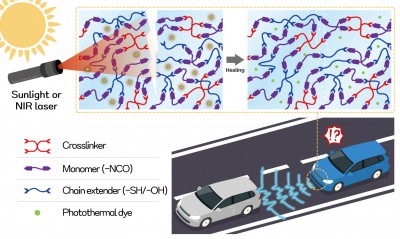
A self-healing lens material could help self-driving cars avoid traffic accidents by removing scratches that can distort what autonomous vehicles see in potentially confusing and dangerous ways, a new study finds.
The main concern limiting the adoption of autonomous technology is likely safety. Indeed, a survey by the American Automobile Association showed the number of respondents who were afraid of using self-driving cars has increased by 13 percent, from 55 percent in 2022 to 68 percent in 2023.
Cameras are a key technology that self-driving cars use to analyze the world to move in a safe manner. However, a scratch on the lens of a camera can significantly distort what that camera sees and mislead autonomous vehicles.
Now scientists in Korea have developed a transparent material that can remove scratches on a lens surface within 60 seconds when sunlight is focused onto it using a simple tool such as a magnifying glass.
Self-healing materials are often made of flexible substances that are relatively simple to restore to an intact state. However, lenses and protective coatings are typically made of hard materials; imparting a self-healing function onto these components is therefore often very difficult.
To solve this problem, the scientists combined a polythiourethane structure that is already being used as a inexpensive lens material with a hard transparent photothermal dye. When the dye absorbs sunlight, it heats up to 75 degrees Celsius, allowing the lens to heal by letting chemical bonds in the thiourethane break apart and then recombine together.
The new lens material can self-healing perfectly even when scratches cross each other. It is also resilient, healing with 100 percent efficiency even if the process of scratching and healing at the same location is repeated more than five times.
The scientists noted the new dye selectively absorbs light from specific near-infrared 850-to-1050-nanometer wavelength light. This means that it does not interfere with the visible 350-to-850-nanometer wavelength light that cameras rely on, nor the near-infrared 1,550-nanometer wavelength light that LiDAR sensors use.
The researchers suggest this new self-healing material may not only prevent autonomous car accidents, but also increase the life expectancy of the vehicles.
“It is expected to be widely used in various applications such as autonomous vehicle sensors, as well as glasses and cameras,” Young Kuk Lee, president of the Korea Research Institute of Chemical Technology, said in a statement.
The scientists detailed their findings on February 1 in the journal ACS Applied Materials & Interfaces.

